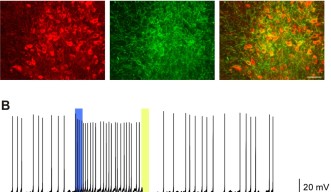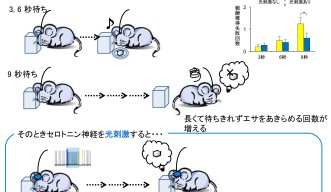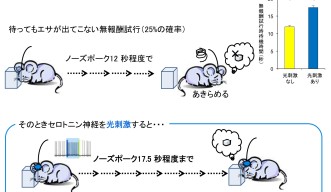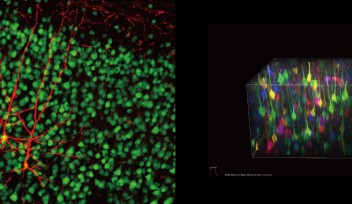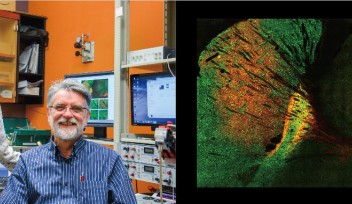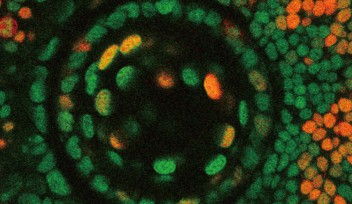Fed Up with Waiting? Timely Activation of Serotonin Enhances Patience

Lining up in a long queue for a popular restaurant or waiting for the arrival of a date requires a great deal of patience. Our lives are full of decisions involving patience, yet it needs to be exercised at the appropriate times. In order to examine the brain mechanism for controlling patience to obtain a reward, Drs. Kayoko Miyazaki and Katsuhiko Miyazaki and Prof. Kenji Doya of the Neural Computation Unit at the Okinawa Institute of Science and Technology Graduate University, used a new technique called optogenetics, where they use light to simulate specific neurons with precise timing. Their most recent research shows that activating serotonin neurons specifically during waiting promotes patience for delayed rewards. This research was published in the online version of Current Biology on August 21, 2014.
In this study, the researchers used genetically engineered mice that produce light-activated molecules only in neurons that produce serotonin (Figure 1). They implanted an optical fiber in a small part of the brain called the dorsal raphe, from which neural fibers releasing serotonin extend throughout the cerebrum, the largest and most highly developed part of the brain. The researchers trained five of those mice to perform a delayed reward task, meaning that if they waited at a hole, they would receive a food pellet as a reward. To show that they were waiting, each mouse needed to hold its nose inside the hole where the food pellet would appear, a posture that the researchers call a nose poke. The durations of waiting were randomly chosen from 3, 6, or 9 seconds, or infinity, meaning no reward was given no matter how long the mice waited. In half of those trials, researchers stimulated serotonin neurons by shining a light through the optical fiber while the mice were waiting. No prior signal was given to notify how long the waiting would be. The mice consistently waited for 3 and 6 seconds to receive the food. But when the mice needed to wait for 9 seconds, the mice showed difficulty and often removed their nose from the food hole. When the researchers shone a light on serotonin neurons during the nose poke position, the light stimulation significantly decreased the number of failures to wait for 9 seconds to obtain the food (Figure 2).
In the 25% of trials, the food pellet reward was not delivered regardless of how long the mouse waited. In these trials, without their serotonin neurons stimulated, mice waited 12.0 seconds on average. With their serotonin neurons stimulated, the mice waited 17.5 seconds on average (Figure 3). As control experiments, the researchers activated serotonin neurons at different timing when each mouse did not have its nose poked into the food hole, then observed that these mice behaved the same as in unstimulated cases with no evidence of simple motor inhibition. The results showed, for the first time, that the timed activation of serotonin neurons promotes animals’ patience for delayed rewards.
Serotonin is a neuromodulator that is released diffusely in the entire brain. It is involved in behavioral, cognitive, and mental functions. Classically, serotonin was believed to signal punishment and inhibit behaviors. However, serotonin enriching drugs, known as SSRI, are effective for therapies of depression, which is hard to reconcile with the classic view. Another recent study of optogenetic stimulation of serotonin neurons even reported its effect as a reward, to further complicate the story. On the other hand, another line of research, including the previous work by the OIST researchers, showed that the lack of serotonin causes impulsive behaviors. “Our previous studies have shown that serotonin levels increase when waiting for delayed rewards. We have also shown that inhibiting serotonin neurons leads to an inability to wait for a long time,” explained Kayoko and Katsuhiko Miyazaki. “By using light to stimulate neurons at specific times, this study has proven serotonin’s role in patience during delayed reward waiting, underlining serotonin’s much greater role than previously thought.” By further exploring the effect of serotonin, the researchers hope to decipher the neuronal network behind mental disorders and behaviors involving serotonin. Such studies can promote a better understanding of human emotions, including the development of software and robots that think and act like humans.
Supported by the Strategic Research Program for Brain Sciences of the Japanese Ministry of Education, Culture, Sports, Science and Technology (MEXT), this study took place under collaboration between OIST researchers, Prof. Kenji Tanaka of Keio University, and their colleagues at other research institutions in Japan.
Specialty
Research Unit
For press enquiries:
Press Inquiry Form










